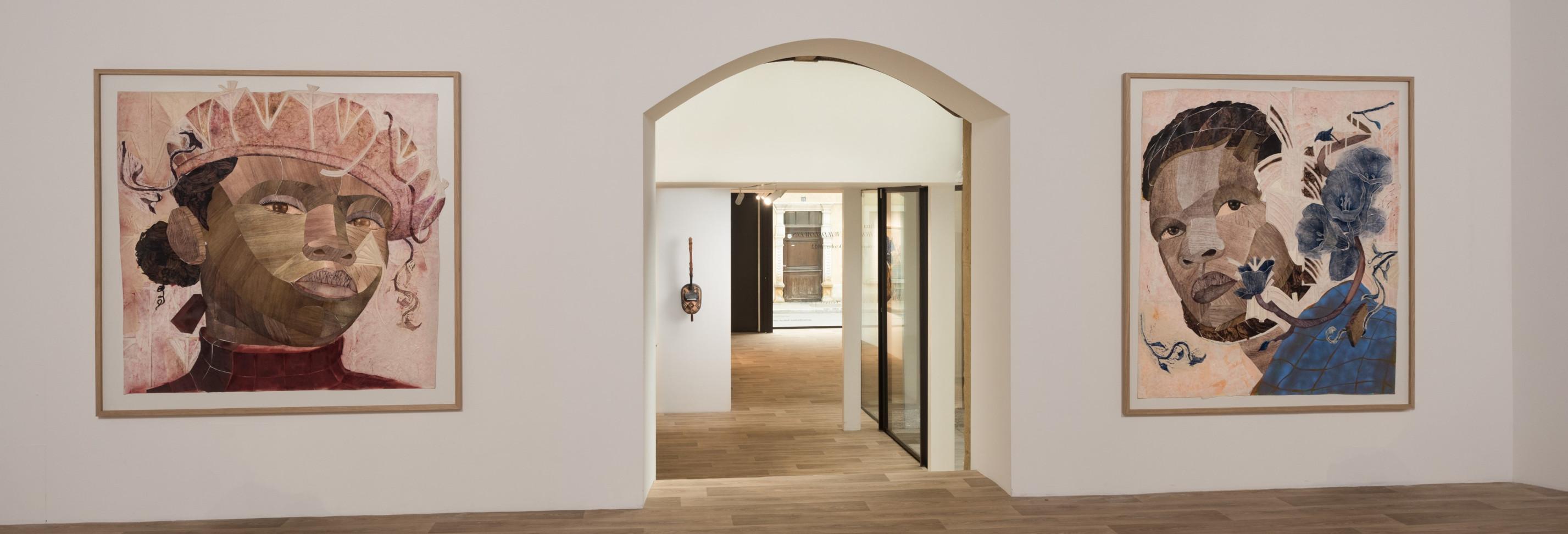
WE HOLD THE WILDFLOWERS
Yashua Klos
Exhibition from 22 September to 29 October 2022
We Hold The WildFlowers, is the artist’s first solo exhibition with the gallery, which follows his first solo museum exhibition Our Labour at The Wellin Museum in Clinton NY.
Klos, born in Chicago Illinois, has recently reconnected with the patrilineal side of his family through a DNA test only four years ago. Klos’ employs a unique process of constructing collages made of his own woodblock prints to mine his family history through portraiture. Like many African American families - Klos' family moved from the South during the Great Migration, for jobs in Detroit’s Auto plants. The city grew quickly- propelled by its Black population. The demand of capitalism would soon ship these same jobs over-seas; downsizing Detroit’s factories and abandoning this work force. Today, the city’s abandoned buildings and land plots are being reclaimed by the weeds and wildflowers native to Michigan prairie land.
Klos employs images of these wildflowers as reference to that same sprawling migration, and to the resilience of the Black population who built the American Midwest through industrial labor. Conversely, Detroit also has many well-maintained landmark buildings in the Art Deco architectural style that arose during the city’s industrial growth. Klos references the city’s once ambitious identity through Art Deco design patterns, which haunt the pictorial space from the background, and often appear impressed upon the faces of his portrait subjects.
In the artist words…
“One’s identity cannot be separated from the geography around them. Just as the environment is built by people, the environment in turn – builds us.
Woodblock printing has a rich history in African American artistic production as a medium for creating political posters, pamphlets, and illustrations. Artists like Elizabeth Catlett and Charles White used the medium to render positivist images of Black Americans as the statuesque and capable builders of America. Klos comes after this tradition, as its newest generation, aiming to reconsider notions of the Black figure as one that need not be depicted at work, but rather here resting…amongst the Wildflowers.
This exhibition also includes one sculpture that Klos makes by stacking cubits of maple wood, which are then sanded down, stained, and charred through torching. The Western art history canon credits Pablo Picasso with pioneering abstraction through his Cubism based on African tribal mask forms. In this sculpture the artist reduces ‘cubism’ to ‘cubits’ of wood; a gesture toward inverting the canon, and reclaiming abstraction at its African origins.
Klos’ mask is hybrid of automotive welding masks and West African tribal masks. The welding mask hides identity through its function: protecting the laborer. The African tribal mask functions to summon and activate an identity for the wearer to embody. A traditional tribal mask is activated during ceremonial theater once it is ‘danced’. Klos, however, activates this mask through his own torching ceremony. He has said ‘Charing is an act that fuses my own creative labor with my family’s contemporary history in labor, and also further back to the ancestral West African sculpture tradition.’
CATALOGUE
At this occasion an exhibition catalogue will be published with a written essay by Dexter Wimberly, Senior Critic at the New York Academy of Art.
BIOGRAPHY
Yashua Klos was born in 1977 in Chicago, Illinois, lives in Harlem and works in the Bronx, New York. He is a visual artist who employs a unique process of collaging his own woodblock printed textures to engage ideas about Blackness as an adaptive material for survival strategies. Klos’ work has been shown in museums and galleries across the states and internationally, including the Studio Museum of Harlem, the Weatherspoon Museum, Greensboro, North Carolina, What If The World in Johannesburg, South Africa, Tilton Gallery in New York City, and UTA Artist Space in LA. Klos’ first solo museum show was in 2022 at the Wellin Museum in Clinton NY. Klos’ works have been reviewed in the NY Times, and he’s been awarded residencies at Skowhegan, The Vermont Studio Center, and Bemis. He is the recipient of a Joan Mitchell Fellowship and a NYFA grant. His work is part of the collections of Kalamazoo Institute of Arts and Wellin Museum at Hamilton College.